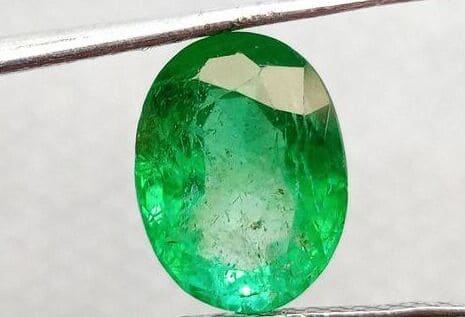

Emerald treatments: To enhance the clarity, color, brilliance, and to make the stone more durable, emeralds are generally treated with oil or resin. Almost all the emeralds have internal and surface-reaching open fissures, so filling them to make stone look more transparent, lusterous, and colorful, the aforesaid materials and sometimes other fillers are used. It should always be assumed that an emerald is treated unless it is proven for no treatments.
Oiling is done on both rough and finished emeralds. The naturally occurring emerald rough has lots of internal cracks or fissures (internal hollow cracks). For oiling, simply an emerald is dipped in oil or oil is applied to the surface and left for some time, from a few hours to a couple of days, so that the air filled in the fissures is replaced by the oil, as the emerald has the property to soak the oil in it. The oil used for it can be colorless cedar wood oil, joban oil with color, or any other mineral or vegetable oil.
Impact of oiling: After oiling the hollow inner cracks gets filled with oil vailing the shaggy appereance of the gemstone which was due to many fissures making the stone look whitish, weak and deteriorated. After oiling, the stone looks more transparent as the fissures get intermingled with the rest of the crystals, which were before separated, giving it a uniform look that is more shiny, and even the color is improved sometimes due to evenness bought up in the gem. The refraction of the light gets unified in the emerald cluster due to the filling of the fissures, thus giving it better transparency and luster.
Minor and moderate (extent F1-F2): Here the emeralds have very little traces of oil in them, which is not hiding any big cracks, and only a few fissures have oil, which may not dry early. Even if the oil dries up in F1-F2 graded gemstones, the stone does not show a significant change in appearance.
Significant oiling (extent F3): Any such emerad with significant or heavy oiling will dry up early, showing flaws in the stone with usually white patches, which may be significant.
Note: Some gemologists give oil grade just by the amount of fissures in emerald, even if it does not have oil in it. IGI, GIA, Guild and other few labs certifies some minor oiled emeralds as moderate even if the emerald has no tendency to dry out, and for the same emerald, GJEPC IIGJ (one of the best labs for color stones in India) gives minor oil (F1) enhancement because of no to minor tendency of the stone getting dry out.
As the oil dries up, leaving the emerald in the old state it was before, oiling is not a strong and permanent solution for enhancing the gemstone, as oil inside generally starts to dry up in a couple of days to months depending on the kind of cracks and fissures in the stone. The oiling has to be done from time to time; otherwise, in some cases, the stone can become vulnerable. A better alternative to oil is natural resin, which also acts the same as oil, filling up the fissures but is more stable.
Note: In my many years of experience, I have seen that in many cases the extent of enhancement given in certification does not match the quality or the real amount of enhancement done. IGI or GIA can many times give a minorly oiled emerald as moderate, and a significantly oiled specimen as moderate. This result in observations where a moderate treatment (F2) graded stone is drying out before the F3 graded emerald sometimes. Even the various laboratories have their own criteria for grading emerald on the basis of treatment, as some actually see the amount of oil in fissures present and some just by the amount of cracks or hollow space present in stone by which the potential to absorb oil is seen, the grading is given.
In actuality, significantly oiled stones are those that dry up too much and the whole appearance of the stone changes when kept free from oil for a certain period of time, and big white patches or cracks start to appear, but if a stone is not changing much after being kept out of oil for a longer period of time, it is surely a minor oiled stone.
As we know, emeralds come with a lot of cracks and fissures, and a lot are surface-reaching, so to cover them up traditionally, many oils and natural rasins were used, like cedar oil or Canadian balsam, but now even epoxy or chemical resins are used in the place. Sometimes epoxy is used just to fill up a micropit or pits on the surface, and the enhancement can be very minor. Also epoxy is used to fill bigger inner cracks as a durable treatment, furthermore it solidify the brittle stones as well from within.
Resin is a better way to treat emerald, as it does not dry up as quickly as oil does, but over a period of time the resin disintegrates. It can also be removed with some solvents if needed.
Resin and oil can combinedly be used, as even resin-treated emeralds are always oiled. So resin is a better solution for enhancing emeralds compared to oil in my opinion.
Almost all emeralds are treated with resin or oil, so if that is in a minor amount, then there is no change in the emerald's price, but if it has significant oiling, the price drops less than half in respect of the quality seen.
If suppose a minor or no-oiled emerald in 3 carats is of $1500/ct, then the same color/clarity emerald in resin will be $1100/ct - $1200/ct around.